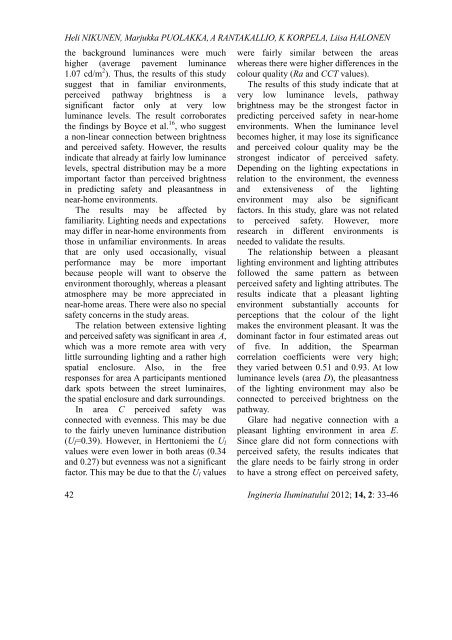Untitled - Journal of Lighting Engineering
Untitled - Journal of Lighting Engineering
Untitled - Journal of Lighting Engineering
You also want an ePaper? Increase the reach of your titles
YUMPU automatically turns print PDFs into web optimized ePapers that Google loves.
Heli NIKUNEN, Marjukka PUOLAKKA, A RANTAKALLIO, K KORPELA, Liisa HALONEN<br />
the background luminances were much<br />
higher (average pavement luminance<br />
1.07 cd/m 2 ). Thus, the results <strong>of</strong> this study<br />
suggest that in familiar environments,<br />
perceived pathway brightness is a<br />
significant factor only at very low<br />
luminance levels. The result corroborates<br />
the findings by Boyce et al. 16 , who suggest<br />
a non-linear connection between brightness<br />
and perceived safety. However, the results<br />
indicate that already at fairly low luminance<br />
levels, spectral distribution may be a more<br />
important factor than perceived brightness<br />
in predicting safety and pleasantness in<br />
near-home environments.<br />
The results may be affected by<br />
familiarity. <strong>Lighting</strong> needs and expectations<br />
may differ in near-home environments from<br />
those in unfamiliar environments. In areas<br />
that are only used occasionally, visual<br />
performance may be more important<br />
because people will want to observe the<br />
environment thoroughly, whereas a pleasant<br />
atmosphere may be more appreciated in<br />
near-home areas. There were also no special<br />
safety concerns in the study areas.<br />
The relation between extensive lighting<br />
and perceived safety was significant in areaaA,<br />
which was a more remote area with very<br />
little surrounding lighting and a rather high<br />
spatial enclosure. Also, in the free<br />
responses for area A participants mentioned<br />
dark spots between the street luminaires,<br />
the spatial enclosure and dark surroundings.<br />
In area C perceived safety was<br />
connected with evenness. This may be due<br />
to the fairly uneven luminance distribution<br />
(Ul=0.39). However, in Herttoniemi the Ul<br />
values were even lower in both areas (0.34<br />
and 0.27) but evenness was not a significant<br />
factor. This may be due to that the Ul values<br />
42<br />
were fairly similar between the areas<br />
whereas there were higher differences in the<br />
colour quality (Ra and CCT values).<br />
The results <strong>of</strong> this study indicate that at<br />
very low luminance levels, pathway<br />
brightness may be the strongest factor in<br />
predicting perceived safety in near-home<br />
environments. When the luminance level<br />
becomes higher, it may lose its significance<br />
and perceived colour quality may be the<br />
strongest indicator <strong>of</strong> perceived safety.<br />
Depending on the lighting expectations in<br />
relation to the environment, the evenness<br />
and extensiveness <strong>of</strong> the lighting<br />
environment may also be significant<br />
factors. In this study, glare was not related<br />
to perceived safety. However, more<br />
research in different environments is<br />
needed to validate the results.<br />
The relationship between a pleasant<br />
lighting environment and lighting attributes<br />
followed the same pattern as between<br />
perceived safety and lighting attributes. The<br />
results indicate that a pleasant lighting<br />
environment substantially accounts for<br />
perceptions that the colour <strong>of</strong> the light<br />
makes the environment pleasant. It was the<br />
dominant factor in four estimated areas out<br />
<strong>of</strong> five. In addition, the Spearman<br />
correlation coefficients were very high;<br />
they varied between 0.51 and 0.93. At low<br />
luminance levels (area D), the pleasantness<br />
<strong>of</strong> the lighting environment may also be<br />
connected to perceived brightness on the<br />
pathway.<br />
Glare had negative connection with a<br />
pleasant lighting environment in area E.<br />
Since glare did not form connections with<br />
perceived safety, the results indicates that<br />
the glare needs to be fairly strong in order<br />
to have a strong effect on perceived safety,<br />
Ingineria Iluminatului 2012; 14, 2: 33-46
















